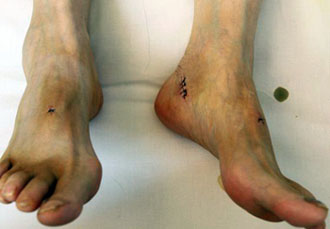
Introduction to
Diabetic Peripheral NeuropathyPeripheral neuropathy is disorder of nerve(s) apart from the brain and spinal cord. Patients with peripheral neuropathy may have tingling, numbness, unusual sensations, weakness, or burning pain in the affected area. Oftentimes, the symptoms are symmetrical and involve both hands and feet. Because the symptoms are often present in the areas covered by gloves or stockings, peripheral neuropathy is often described as having a "glove and stocking" distribution of symptoms.
Peripheral neuropathy can involve different nerve types, including motor, sensory, and autonomic nerves. Peripheral neuropathy can also be categorized by the size of the nerve fibers involved, large or small.
Neuropathy can present with many differing symptoms, including numbness, pain of different types, weakness, or loss of balance, depending on the type of nerve involved. Because the autonomic nerves control bodily functions that we do not consciously think of, such as heart rate, digestion, and emptying of the bowel and bladder, autonomic neuropathy manifests with symptoms affecting the loss of control of these functions. Symptoms may include problems with blood pressure, voiding, passage of stools (diarrhea, or constipation), heart rate, or sweating.
Cranial neuropathy is similar to peripheral neuropathy, except that the cranial nerves are involved. Any of the cranial nerves can be involved. One of the more common causes of cranial neuropathy is loss of blood flow from the optic artery to the optic nerve, causing ischemic optic neuropathy. Amyloidosis is one of the more common causes of this rare disorder.
Specific nerves can be involved in neuropathy. When a specific nerve is involved, the symptoms are limited to the distribution of that nerve. The most commonly involved peripheral nerve is the median nerve at the wrist in carpal tunnel syndrome. Essentially any peripheral nerve can become entrapped and cause the signs and symptoms of neuropathy. The ulnar nerve is commonly entrapped at the elbow. The peroneal nerve is exposed at the outer part of the knee. The pudendal nerve can cause pain in the perineum and is relieved by sitting on a toilet seat or an inflatable donut. Entrapment of the lateral femoral cutaneous nerve at the waist, called meralgia paresthetica, causes numbness at the outer part of the thigh.